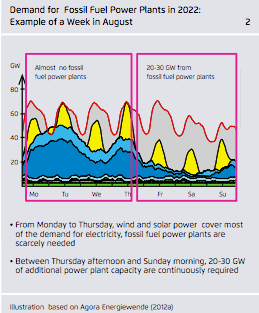Please click here for more graphs of the day
Anyone who has observed recent developments in Germany, and to a growing extent in Australia, will have noted the rapidly changing dynamics of electricity markets caused by the growth in renewables. So much so, that according to this graph of the day, the concept of baseload power may be redundant in Germany within a decade.
The graph of the day shows how Germany’s electricity market might look like in 2022, in a week of August, when windy and sunny weather help wind farms and solar plants deliver most of the electricity requirements, needing little extra from fossil fuel plants (nuclear power has already been closed). On the other days, however, there is less wind and solar, so more fossil fuel is required.
What does this mean for baseload power stations? The irony is that while “intermittent sources” such as wind and solar are criticised now for being unsuitable for our energy market needs, in the future it will be the “base load” generators which will be unsuitable for our energy market needs.
That’s because they will get squeezed out of the market. The gaps in the energy market will need to be filled by flexible generators. The leading germany utilities have already recognised this. The most recent new coal fired plants are designed for such flexibility, able to ramp up and down 500MW in less than half an hour. Gas, though, is the preferred source over coal. In sunny countries, it will likely be solar thermal with storage. Elsewhere, it will be hydro.
This is a complete change from the past, where baseload power trundles throught the night and day and is augmented by “peaking” power, usually expensive fast response gas generation, when demand increases.
According to the report by Agora Energiewende, by 2022 there will be enough wind, solar and other renewable generation in Germany to cover total load (base, mid- and peak- load) during many hours throughout the year, as shown in the graph of the day.
It notes that power plants must be rapidly ramped up and down over short periods of time in order to compensate for these fluctuations. As the share of wind and solar power increases, this will also apply to the few remaining “base-load power plants”. In the future, all remaining fossil fuel power plants will need to operate on a flexible basis.
This is exactly what UNSW researchers Mark Diesendorf, Ben Elliston and Iain McGill predicted in their scenarios for 100 per cent renewable energy for Australia, and David Mills concluded in his scenario in the US. Their scenarios were divided between inflexible and flexible generation, or renewables and dispatchable generation.
Time will tell whether dispatchable generation, particularly in solar rich nations such as Australia, will ultimately be delivered by gas, or technologies such as solar thermal with storage – as well as existing hydro. The authors at Agora Energiewende say wind power and solar will form the basis of a future, low-carbon energy system in many countries, and will face similar challenges that Germany is facing today.
In the meantime, to achieve that transition in the most cost effective way, German policy makers are looking for ways to redefine energy markets. The traditional means of paying per kilowatt hour, which more or less protected the incumbent industry, now seems redundant because wind and solar have no fuel costs.
Capacity markets, where plants get payments for existing, are not the solution either – so work in now being done on the development of “capabilities markets” which reflects the value of energy provided, in economic, availability and environmental terms. As the Agora report notes: “The challenge is not about technology and control, but rather about incentives.”







